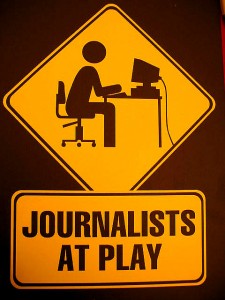Yes, print journalism is struggling these days, but does that mean we don’t have anything to learn from our favorite newspapers and magazines? After all, the craft has been undergoing continual refinement for hundreds of years, and plenty of smart people have chosen careers in journalism, so it stands to reason that taking advantage of a few journalist tricks ought to enhance our workplace writing.
So what’s a prime example?
One of my favorites––sorely underused in workplace emails, reports, and other written formats––is subheads. Knowing that most of our readers are plowing through an avalanche of messages every day, we can do our readers––and ourselves––a favor by breaking up our text into smaller paragraphs (another journalistic approach) and, wherever useful, providing a subhead.
So let’s say we are giving several colleagues an update on three aspects of a project. Obviously, we want to parcel out our information in at least three paragraphs, but can we do better? Sure. The sections could begin with subheads like this:
Timeline. Xxxxxx …
Vendors. Xxxxxx …
Budget. Xxxxxx …
Because this simple technique enhances the visual presentation of our message, the subheads are likely to increase the chances that our message will be read all the way through, comprehended more easily, and appreciated.
Can we do more with subheads?
You bet. What if we provide a stronger lead-in by being more specific, and what if we use bold or italic to enhance the visual appeal further? Then that first subhead might look like this:
Revised project timeline. Xxxxxx … OR
Oct. 1–Nov. 30 timeline. Xxxxxx …
But don’t newspaper headlines almost always contain verbs? Should we consider doing that in our subheads? Let’s see if that further bolsters our communication.
Timeline altered to accommodate marketing plan. Xxxxxx … OR
Project due date extended to Nov. 30. Xxxxxx …
Are there formatting rules?
You have plenty of latitude in setting up your format. For example, if you like to present the subhead by itself and drop down to begin the paragraph, go for it:
Budget buttressed by new grant
Xxxxxx
But consistency is a key to polished writing, so one “rule” you might want to impose on yourself is sticking with your subhead format. Therefore, you wouldn’t want one subhead to contain a verb (Budget increased 12 percent over last year), and the next to have no verb (Additional vendors). Stylistic meandering can distract the reader.
(Notice that each of my subheads in this post is a question. I’m not sure I needed to go that far for the sake of consistency, but I worried that if I didn’t you’d call me on it.)
How else can subheads help?
Let’s close with one more tip. Do you ever fret that by the end of a longish email you’ve worn out your reader, and now the reader is going to blow off your attachment(s)? So rather than vaguely referring to an “attachment below” in the middle of a message and leaving it at that, why not increase the likelihood that a reader will take the time to open an attachment by “advertising” it with an enticing lead-in at the bottom?
Two-year sales summary OR
Profiles of top three candidates
Yes, creating subheads adds a bit of time to the writing process, but usually the difference is slight––especially considering the dividends that small investment yields. And besides, playing journalist can make the writing process more enjoyable.
In addition to presenting workshops on writing in the workplace, Norm Friedman is a writer, editor, and writing coach. His 100+ Instant Writing Tips is a brief “non-textbook” to help individuals overcome common writing errors and write with more finesse and impact. Learn more at http://www.normfriedman.com/index.shtml.










